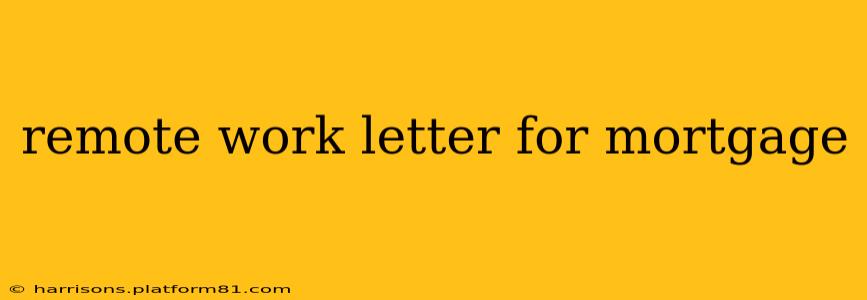Securing a mortgage while working remotely can present unique challenges. Lenders need assurance of your financial stability and employment consistency, just as they would with a traditional, office-based job. This comprehensive guide will walk you through crafting a compelling remote work letter that strengthens your mortgage application. We'll address common lender concerns and provide practical tips to increase your chances of approval.
What Information Should a Remote Work Letter Include?
A strong remote work letter needs to address lender concerns head-on. It should clearly demonstrate your stable employment and consistent income. Here's a breakdown of essential information to include:
- Your Full Name and Contact Information: Start with the basics, ensuring accuracy.
- Date: Include the date of the letter.
- Lender's Name and Address: Address the letter to the specific mortgage lender.
- Your Employer's Name and Address: Clearly state your employer's legal name and physical address.
- Your Job Title: Specify your exact job title.
- Start Date of Employment: Include your official start date with the company.
- Your Employment Status: Explicitly state that you are a full-time employee.
- Nature of Your Remote Work: Briefly describe your work responsibilities and how you perform them remotely. Emphasize the consistency and stability of your role.
- Confirmation of Remote Work Policy: State that your employer has a formal remote work policy or that your remote work arrangement is approved and documented.
- Income Verification: Provide details on how your income is verified (e.g., pay stubs, W-2 forms, tax returns, bank statements).
- Contact Information for Your Employer: Include a phone number and email address for your employer, giving the lender a way to verify your employment.
- Statement of Continued Employment: A crucial element! Explicitly state your expectation of continued employment with the company for the foreseeable future.
- Your Signature: Sign and date the letter.
What if I'm Self-Employed or a Freelancer?
If you're self-employed or a freelancer, the requirements slightly differ. Instead of an employment letter, you'll need to provide comprehensive financial documentation. This usually includes:
- Tax returns (typically the last two years): Demonstrates your income history.
- Profit and loss statements: Shows your business's financial performance.
- Bank statements: Provides a clear picture of your cash flow.
- Client contracts: Illustrates your ongoing work and income streams.
How Long Should My Remote Work Letter Be?
Keep it concise and focused. A well-written letter shouldn't exceed one page. Clarity and precision are key; avoid unnecessary jargon or lengthy explanations.
Can I Use a Template?
While templates can be helpful for structure, always personalize the letter to reflect your specific situation and employer's policies. Using a generic template could raise red flags with the lender.
What if My Employer Doesn't Provide a Letter?
If your employer is unable or unwilling to provide a formal letter, you need to proactively address this with your lender. Alternative documentation like pay stubs, bank statements, and contracts might be sufficient. Open communication with your lender is vital in such situations.
How to Increase Your Chances of Mortgage Approval
Beyond the letter, several factors influence mortgage approval:
- Strong Credit Score: A high credit score significantly improves your chances.
- Low Debt-to-Income Ratio: Keep your debts low relative to your income.
- Sufficient Down Payment: A larger down payment often reduces lender risk.
- Stable Income History: Consistent income over time reassures lenders.
Remember, preparing a thorough and well-written remote work letter is a critical step in securing a mortgage. By addressing lender concerns directly and providing comprehensive documentation, you can significantly increase your chances of approval. Consult with a mortgage professional for personalized advice tailored to your specific situation.
